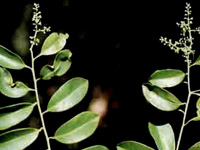Bai Bidanga (Embelica ribes)

Cultivation requirements :
Climate :
It grows in temperate to tropical regions. It needs moist soil and partial shady region for favourable growth. It can be grown under different agro-climatic conditions. Temperature ranging from 250 to 300C and rainfall of 50-150 cm. is suitable for its growth.
Soil :
It thrives well on variety of soil ranging from black cotton soil to sandy or rocky soils. Moist soil with rich organic matters is preferable for its healthy growth.
Cultivation details :
Type of propagation :
It is propagated by using seeds (nursery raising).
Time of cultivation :
Nursery beds are raised during the months of May- June. Suitable climatic condition for its cultivation/ transplantation is at onset of monsoon.
Preparation of land :
The land is prepared by deep ploughing, 2-3 times. The soil is well mixed with compost manure, made free of weeds and leveled. The pits of 30 x 30 cm size are prepared or rows are prepared at distance of 60 cm.
Raising nursery beds :
Nursery beds are raised by using mixture of sand, soil and compost manure or farmyard manure. The seeds are sown at regular intervals during May- June. They are lightly watered after sowing. About 5 kgs of seeds are required for preparing 10,000 plants, which are required for planting in one acre of land. The nursery beds, are watered at regular interval till the seedlings are grown up enough for transplanting in the fields. Usually after a period of 5-6 months, the seedlings are ready for transplanting process
Transplantation :
The seedlings are transplanted in heavily manured fields at a distance of 60 x 60 cm. After transplanting, seedlings are lightly irrigated. About 10, 000 plants are planted in an acre of land.
Irrigation :
It is a moisture loving plant and needs irrigation at regular intervals. To keep the soil moist; usually they are irrigated at an interval of 15 days. During rainy season, irrigation schedule be cut down, so as to abvoid water logging in the soil.
Harvesting and collection :
After two years of plantation, the crop is ready for harvesting. Generally, after two years, it bears fruits during August- September. When the fruits attain maturity, they are harvested manually in the months of December- January. The harvested fruits are dried in shade carefully.
Yield :
On an average, yield of dry fruits is about 15 to 20 Qtls/ Hec after second year f plantation.
Approximate economics of cultivation (per hectare) :
Ist Year |
Rs. |
IInd |
Rs. |
Preparation of land
Nursery raising
Seeds
Irrigation
Planting
Manure/ fertilizers
Weeding
Miscellaneous expenditure |
2000
2500
800
2000
1200
3000
1500
1200 |
Irrigation
Manure/ fertilizer
Weeding
Harvesting
Miscellaneous |
1500
1500
1200
3000
1200 |
Total |
14, 200 |
Total |
8, 400 |
Total expenditure= Ist + IInd year
14, 200 + 8, 400 = Rs. 22600
Returns :
Average yield of dry fruits after two years = 15 to 20 Qtl/ Hect.
Sold at rate of 40 – 50 Rs./ Qtl.
Return = 1500 x 40 = Rs. 60,000
Net income = 60,000- 22,000 = Rs. 37, 400.
- Cultivation of medicinal plants by Dr. C.K.Kokate, Dr. A.S.Gokhle and Prof. S.B.Gokhle
- Cultivation of medicinal and aromatic rops by A.A.Farooqi and B.S.Sreeramu
|

